Top 5 vegetable protein sources!
-
When you think of proteins, you probably think of meat, eggs, yogurt and other animal products. But did you know that there are also many vegetable protein sources? Not only interesting for people who do not eat meat or animal products, also ideal for meat lovers among us, as a variety of steak and chicken bones.
-
When you think of proteins, you probably think of meat, eggs, yogurt and other animal products. But did you know that there are also many vegetable protein sources? Not only interesting for people who do not eat meat or animal products, but also ideal for meat lovers among us, to alternate with the steak and chicken bones.
-
We give you the top 5 vegetable protein sources. To compile the top 5, we first look at a number of product groups to find out which protein-rich plant foods there are, why proteins are essential and how much protein you need per day.
What are proteins good for?
-
Proteins are indispensable in your daily diet. Proteins are not only essential for the production of cells, but also for the building of muscles. The real athletes among us probably know all about this and benefit from extra protein intake. Children, pregnant women and people who eat vegetarian or vegan also need extra protein.
-
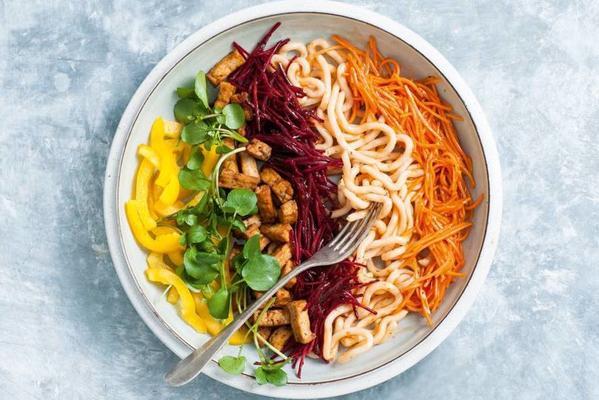 11 minMain dishpeanut oil, tofu stir-fry cubes finely seasoned, stir fry sauce sweet and sour, thick noodles, carrot julienne, beetroot julienne, yellow bell pepper, watercress,rainbow salad with tofu
11 minMain dishpeanut oil, tofu stir-fry cubes finely seasoned, stir fry sauce sweet and sour, thick noodles, carrot julienne, beetroot julienne, yellow bell pepper, watercress,rainbow salad with tofu -
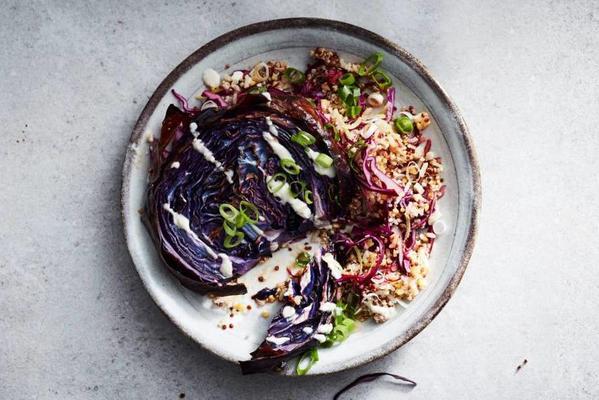 45 minMain dishRed cabbage, mild olive oil, quinoa plus, forest outing, lemon, sesame oil, soy sauce less salt, Bio Today tahini white in pot, tap water,grilled red cabbage with quinoa salad
45 minMain dishRed cabbage, mild olive oil, quinoa plus, forest outing, lemon, sesame oil, soy sauce less salt, Bio Today tahini white in pot, tap water,grilled red cabbage with quinoa salad -
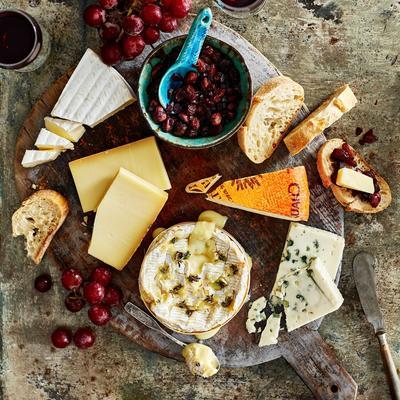 30 minDessertBrie, Roquefort, port salut, gruyere, Camembert, walnut, garlic, thyme, honey, grape, baguette, Red onion, red grape, raisins, Red wine, Red wine vinegar, Brown sugar,generous cheese plate with onion marmalade
30 minDessertBrie, Roquefort, port salut, gruyere, Camembert, walnut, garlic, thyme, honey, grape, baguette, Red onion, red grape, raisins, Red wine, Red wine vinegar, Brown sugar,generous cheese plate with onion marmalade -
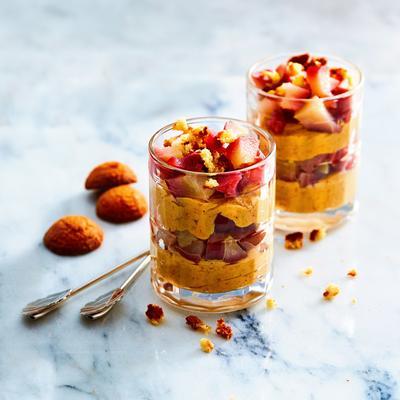 30 minDessertFull Milk, whipped cream, macaroon, custard powder, vanilla sugar, sugar, protein, amaretto, almond liqueur, basic recipe cooking pears,macaroon pastry with casserole
30 minDessertFull Milk, whipped cream, macaroon, custard powder, vanilla sugar, sugar, protein, amaretto, almond liqueur, basic recipe cooking pears,macaroon pastry with casserole
-
For non-athletes applies: 0.8 grams of protein per kilo of body weight per day. For example, do you weigh 70 kilos? Then you need 70 x 0.8 = 56 grams of protein every day. Endurance athletes need more protein, about 1.2 to 1.4 grams of protein per kilogram of body weight. For strength athletes, the requirement is even higher, namely 1.5 to 1.8 grams per kilogram of body weight.
-
You can of course get these from a fried egg with bacon or vegetable protein powders, but vegetable protein sources from the 5 categories below are certainly possible.
-
You can of course get that from a fried egg with bacon or vegetable protein powders, but vegetable protein sources from the 5 categories below are certainly possible.
-
Vegetables are pre-eminently vegetable protein sources. In addition to a whole load of vitamins and minerals, vegetables also provide you with proteins. For example, artichokes, mushrooms, broccoli and spinach for vegetables contain a relatively large amount of protein - between 2-3 grams of protein per 100 grams. But in the vegetables category, kale really excels: it contains about 4 grams of protein per 100 grams.
-
Vegetables are vegetable protein sources par excellence. In addition to a whole load of vitamins and minerals, vegetables also provide you with proteins. For example, artichokes, mushrooms, broccoli and spinach for vegetables contain a relatively high amount of protein - between 2-3 grams of protein per 100 grams. But in the vegetables category, kale really excels: it contains about 4 grams of protein per 100 grams.
-
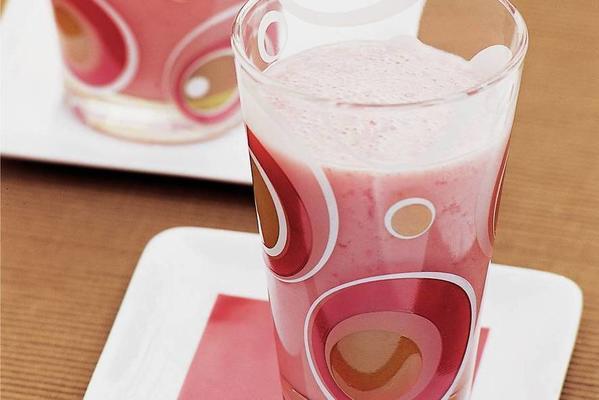 5 minDrink without alcoholbananas, cool fresh apple-pear raspberry juice, Soy drink vanilla,soy fruit shake
5 minDrink without alcoholbananas, cool fresh apple-pear raspberry juice, Soy drink vanilla,soy fruit shake -
 20 minMain dishsauerkraut, sticking potato, liquid baking product, half-to-half minced, Spice meatballs, pineapple, olive oil, liquid baking product,gratin sauerkraut dish with minced meat
20 minMain dishsauerkraut, sticking potato, liquid baking product, half-to-half minced, Spice meatballs, pineapple, olive oil, liquid baking product,gratin sauerkraut dish with minced meat -
 40 minMain dishlemongrass, fresh ginger, Red peppers, onions, tomato cubes, fresh cod fillet, coriander, oil, ground turmeric (koenjit), coconut milk, salt,fish in creamy coconut sauce
40 minMain dishlemongrass, fresh ginger, Red peppers, onions, tomato cubes, fresh cod fillet, coriander, oil, ground turmeric (koenjit), coconut milk, salt,fish in creamy coconut sauce -
 15 minSide dishsweet potato, soft goat cheese, egg, spring / forest onion,stuffed sweet potato with egg
15 minSide dishsweet potato, soft goat cheese, egg, spring / forest onion,stuffed sweet potato with egg
-
Just like vegetables, fruit - albeit to a lesser extent - also contains proteins. The protein levels in fruits aren't shockingly high, but hey, better than nothing, huh? Fruits that contain relatively - compared to other fruits - a lot of protein are bananas, avocados, coconut and kiwis.
-
Just like in vegetables, fruit - albeit to a lesser extent - also contains proteins. The protein levels in fruits aren't shockingly high, but hey, better than nothing, huh? Fruits that contain relatively - compared to other fruits - a lot of protein are bananas, avocados, coconut and kiwis.
-
Even a 150 gram piece of melon contains 0.9 gram of protein. There is no real winner in this category, because most fruits contain about the same (or little) protein.
-
Vegetarians and vegans will regularly eat legumes and beans, as these are incredibly rich in protein. A small list to compare the beans. These beans and legumes contain protein (in grams) per serving of 100 grams:
-
 20 minMain dishTasty vine tomato, (olive oil, fresh basil, onion, garlic, Parmigiano Reggiano, zucchini spaghetti, pumpkin spaghetti, mini buffalo mozzarella,lukewarm pumpkin and zucchini spaghetti
20 minMain dishTasty vine tomato, (olive oil, fresh basil, onion, garlic, Parmigiano Reggiano, zucchini spaghetti, pumpkin spaghetti, mini buffalo mozzarella,lukewarm pumpkin and zucchini spaghetti -
 15 minSide dishtraditional olive oil, curry powder, wheat flour, coconut milk, sambal oelek, chicken broth tablet, water, fresh mango,curry sauce with mango
15 minSide dishtraditional olive oil, curry powder, wheat flour, coconut milk, sambal oelek, chicken broth tablet, water, fresh mango,curry sauce with mango -
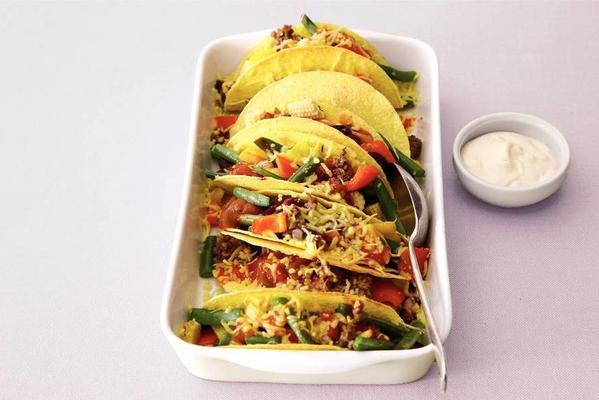 30 minMain dishtraditional olive oil, lean ground beef, frozen Mexican wok vegetables, salsa sauce mild, taco shell, grated young cheese, creme fraiche,Mexican vegetable in tacos
30 minMain dishtraditional olive oil, lean ground beef, frozen Mexican wok vegetables, salsa sauce mild, taco shell, grated young cheese, creme fraiche,Mexican vegetable in tacos -
 95 minMain dishmaize chicken, lemon, coarse sea salt, pepper, extra virgin olive oil, garlic, thyme, zucchini, tomatoes (small to), black olives without pit,provençal chicken with zucchini and tomatoes
95 minMain dishmaize chicken, lemon, coarse sea salt, pepper, extra virgin olive oil, garlic, thyme, zucchini, tomatoes (small to), black olives without pit,provençal chicken with zucchini and tomatoes
-
It will come as no surprise that nuts are high in protein. For the sake of completeness, we also include peanuts in this category, even though it is officially not a nut, but a legume. Per portion of 100 grams, nuts contain protein (in grams):
-
It will not surprise you that nuts contain a lot of protein. For the sake of completeness, we also include the peanut in this category, even though it is officially not a nut, but a legume. Per portion of 100 grams, nuts contain protein (in grams):
-
In some products, of which you might not have expected, turn out to contain proteins. For example, did you know that the following products are rich in proteins? Bean sprouts (2 grams of protein / 100 grams), quinoa, wholemeal pasta and couscous (around 10-14 grams of protein / 10 grams) and - for the good appetite - popcorn! With over 11 grams of protein per 100 grams, this snack is quite high in protein.
-
Some products, of which you might not have expected, turn out to contain proteins. For example, did you know that the following products are rich in proteins? Bean sprouts (2 grams of protein / 100 grams), quinoa, wholemeal pasta and couscous (around 10-14 grams of protein / 10 grams) and - for the good appetite - popcorn! With over 11 grams of protein per 100 grams, this snack is quite high in protein.
Top 5 vegetable protein sources
-
Based on the categories vegetables, fruit, beans / legumes, nuts and unexpected, we propose the following top 5 vegetable protein sources:
-
The carbohydrate / protein ratio is not surprising. Nevertheless, it is definitely worthwhile for your health and for your protein intake to opt for whole-grain products more often. Hence the fifth place for whole grain pasta.
-
Although they are rich in protein, 100 grams of peanuts a day would be a bit too much. You can read why in a previous article about peanuts. But as a snack - and then just one hand - the perfect plant-based, protein-rich snack!
-
Although they are rich in protein, 100 grams of peanuts a day would still be a bit too much. You can read why in a previous article about peanuts. But as a snack - and then just one hand - the perfect plant-based, protein-rich snack!
-
Pistachios are relatively rich in protein, but here too you should not eat too much of them. An 'advantage' of pistachios is that you have to peel them first. This activity reduces the chance that you will be stuffing whole loads in no time.
-
Pistachios are relatively rich in protein, but here too you should not eat too much of them. An 'advantage' of pistachios is that you have to peel them first. This activity will reduce the chance that you will be stuffing whole loads inside in no time.
-
 25 minSmall dishflour, frozen puff pastry, egg, milk, walnut, mature cheese, paprika, dried Provençal herbs,puff pastry-sticks
25 minSmall dishflour, frozen puff pastry, egg, milk, walnut, mature cheese, paprika, dried Provençal herbs,puff pastry-sticks -
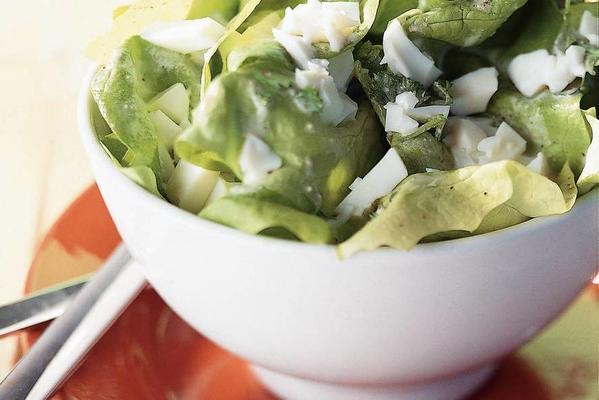 20 minSide dishEggs, lettuce, parsley, olive oil (extra virgin), tarragon vinegar, salt and freshly ground pepper,lettuce with egg dressing
20 minSide dishEggs, lettuce, parsley, olive oil (extra virgin), tarragon vinegar, salt and freshly ground pepper,lettuce with egg dressing -
 15 minSmall dishbaking flour, peanut oil, flat leaf parsley,ar'nabit mi'li
15 minSmall dishbaking flour, peanut oil, flat leaf parsley,ar'nabit mi'li -
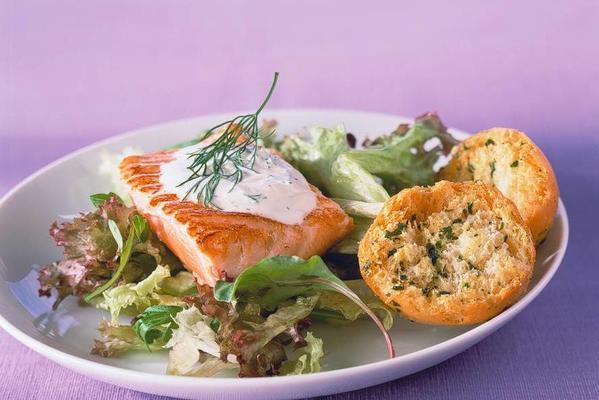 15 minAppetizerScottish salmon fillet, butter or margarine, fresh dill, creme fraiche, dry white wine, arugula lettuce melange, pan tostado,baked salmon with white-wine sauce
15 minAppetizerScottish salmon fillet, butter or margarine, fresh dill, creme fraiche, dry white wine, arugula lettuce melange, pan tostado,baked salmon with white-wine sauce
-
This vegetable contains a relatively high amount of protein in relation to the calories you consume with it. Many people not only use kale as a boiled or steamed vegetable or in the stew, but also put kale in a smoothie, make kale burgers or eat it raw, with the salad. So you can go in all directions with it.
-
Which with over 20 grams of protein per 100 grams are also packed with healthy nutrients and fiber. Eat them as a vegetable with your meal, add them to the salad or eat them for a good appetite. Tasty, healthy and high in protein.